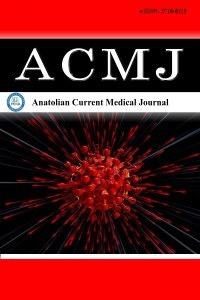The effectiveness of percutaneous nephrolithotomy for the treatment of large impacted upper ureteral stones
The effectiveness of percutaneous nephrolithotomy for the treatment of large impacted upper ureteral stones
___
- Brener ZZ, Winchester JF, Salman H, Bergman M. Nephrolithiasis: evaluation and management. South Med J 2011; 104: 133–9.
- Yasui T, Okada A, Hamamoto S, al. Efficacy of retroperitoneal laparoscopic ureterolithotomy for the treatment of large proximal ureteric stones and its impact on renal function. Springerplus 2013; 2: 600.
- Lee YH, Tsai JY, Jiaan BP, et al. Prospective randomized trial comparing shock wave lithotripsy and ureteroscopic lithotripsy for management of large upper third ureteral stones. Urology 2006; 67: 480–4.
- Vanlangendonck R, Landman J. Ureteral access strategies: pro-access sheath. Urol Clin North Am 2004; 31: 71–81.
- Turk C, Knoll T, Petrik A, et al. Guidelines on urolithiasis. European Association of Urology 2014. http: //www.uroweb.org/gls/pdf/22%20Urolithiasis_LR.pdf. Accessed February 25, 2015.
- Kadyan B, Sabale V, Mane D, et al. Large proximal ureteral stones: ideal treatment modality? Urol Ann 2016; 8: 189–92.
- Ferakis N, Stavropoulos M. Mini percutaneous nephrolithotomy in the treatment of renal and upper ureteral stones: lessons learned from a review of the literature. Urol Ann 2015; 7: 141–8.
- Lee JW, Park J, Lee SB, Son H, Cho SY, Jeong H. Mini-percutaneous Nephrolithotomy vs retrograde Intrarenal surgery for renal stones larger than 10 mm: a prospective randomized controlled trial. Urology 2015; 86: 873–7.
- Hussain M, Ali B, Ahmed S, et al. Prediction of renal function recovery in obstructive renal failure due to stones. J Pak Med Assoc 1997; 47: 159–61.
- Lee JY, Han JH, Kim TH, et al. Laparoendoscopic single-site ureterolithotomy for upper ureteral stone disease: the first 30 cases in a multicenter study. J Endourol 2011; 25: 1293-8.
- McAteer JA, Evan AP. The acute and long-term adverse effects of shock wave lithotripsy. Semin Nephrol 2008; 28: 200–13.
- Mugiya S, Ozono S, Nagata M, et al. Retrograde endo-scopic management of ureteral stones more than 2 cmin size. Urology 2006; 67: 1164–8.
- Segura JW, Preminger GM, Assimos DG, et al. Ureteral Stones Clinical Guidelines Panel summary report on the management of ureteral calculi. The American Urological Association. J Urol 1997; 158: 1915–21.
- Seitz C, Tanovic E, Kikic Z, et al. Impact of stone size, location, composition, impaction and hydronephrosis on the efficacy of holmium: YAG-laser ureterolithotripsy. Eur Urol 2007; 52: 1751–9.
- Lai D, Chen M, He Y, Li X. Simultaneous retrograde intrarenal surgery for ipsilateral asymptomatic renal stones in patients with ureteroscopic symptomatic ureteral stone removal. BMC Urol 2015; 19: 15-22.
- Xiao-jian G, Lin LJ, Yan X. Treatment of large impacted proksimal ureteral stones: Randomized comparison of minimally invasive percutenous antegrade ureterolithotripsy versus retrograde ureterolithotripsy. World J Urol 2013; 31: 1605–10.
- Goel R, Aron M, Kesarwani PK, et al. Percutaneous antegrade removal of impacted upper-ureteral calculi: still the treatment of choice in developing countries. J Endourol 2005; 19: 54–7.
- Juan YS, Shen JT, Li CC, Wang CJ, Chuang SM, Huang CH, Wu WJ. Comparison of percutaneous nephrolithotomy and ureteroscopic lithotripsy in the management of impacted, large, proximal ureteral stones. Kaohsiung J Med Sci 2008; 24: 204-9.
- Yang Z, Song L, Xie D, et al. Comparative study of outcome in treating upper ureteral impacted stones using minimally invasive percutaneous nephrolithotomy with aid of patented system or transurethral ureteroscopy. Urology 2012; 80: 1192-7.
- Wang Y, Zhong B, Yang X, Wang G, Hou P, Meng J. Comparison of the efficacy and safety of URSL, RPLU, and MPCNL for treatment of large upper impacted ureteral stones: a randomized controlled trial. BMC Urol 2017; 17: 50.
- Bozkurt IH, Yonguc T, Arslan B, et al. Minimally invasive surgical treatment for large impacted upper ureteral stones: Ureteroscopic lithotripsy or percutaneous nephrolithotomy? Can Urol Assoc J 2015; 9: 122-5.
- Yayın Aralığı: 6
- Başlangıç: 2019
- Yayıncı: MediHealth Academy Yayıncılık
Recurrence rates and factors affecting recurrence after traumatic anterior shoulder dislocation
Mehmet Ozbey BUYUKKUSCU, Ahmet KULDUK, Abdurrahman AYDIN, Engin ÇETİNKAYA, Şükrü Sarper GÜRSÜ
Müslüm SAĞIR, Mustafa KAPLAN, Alpaslan TANOĞLU, Fevzi DEMİREL
Dilara ÖZYİĞİT BÜYÜKTALANCI, Seyran YİĞİT, Sultan Deniz ALTINDAĞ, Hüseyin AYDOĞMUŞ, Servet GENÇDAL
Mevlüt DOĞUKAN, Öznur ULUDAG, Mehmet DURAN, Murat Abdulhamit ERCİŞLİ, Kıymet CEYHAN, Cengiz GÜVEN, Ayşe BAYSAL
Monocyte/HDL ratio in women with polycystic ovary syndrome and healthy controls
Tuğba GÜRBÜZ, Nefise TANRIDAN OKÇU, Nur DOKUZEYLÜL GÜNGÖR
A comparative study between adolescent and adult patients with pilonidal sinus disease
Ömer KATI, Yaşar KANDUR, Murat KAYA, Ahmet Gökhan GÜLER, Tahir DALKIRAN
Surgical nurses’ knowledge levels about hemodynamic monitoring
Esra ÖZKAN, Nurşen KULAKAÇ, Ceyda UZUN ŞAHİN, Dilek ÇİLİNGİR
Evaluation of spleen volume in thoracic computed tomography in patients with COVID-19 pneumonia
Cesur SAMANCI, Bengü ŞAYLAN, Melike YEŞİLDAL, Eyup CAMURCUOGLU, Fethi Emre USTABAŞIOĞLU
The effects of folic acid on vascular reactivity in a hyperhomocysteinemic rat model
Melek YILMAZ, Hüseyin GEMALMAZ, Cihan YÜCEL, Serkan KETENCİLER, Uğur GÜRCÜN, Berent DİŞÇİGİL
